
When I was in Arcata this spring to do some bird photography, I drove down to Humboldt Bay and stumbled upon the lovely Humboldt Botanical Garden. The Humboldt Botanical Gardens are at the southern edge of Eureka, California. The Gardens are near the South Bay portion of Humboldt Bay on the north side of College of the Redwoods. The Garden was organized by a small group of volunteers in 1991. The goal was to create an educational botanical garden in for the Northern California region. The garden opened in 2006, with more development completed by 2008. Its Lost Coast Brewery Native Plant Garden has an emphasis on the Humboldt region, but includes plants in the geographic area from the Rogue River to the north shore of San Francisco Bay, and inland to a north-south line running from Vacaville through Williams, Redding, Yreka, Medford, and along the Rogue River to its mouth. The Gardens are particularly interested in maintaining complete native conifer, Iris and Lilium occidentale (western lily) collections. They had a beautiful display of spring flowers which I thought I would share.

The 40 odd acres are not completed yet but the garden is off to a nice start, with a fair number of native plants, some interesting imports and tranquil seating overlooking the garden. I took the opportunity to capture some spring flowers in the Garden but there are many more plants and trees to see. The area’s climate, which is balanced between the Mediterranean of Southern California and the Pacific Northwest, allows for very diverse groups of plants to thrive, and accounts for the presence of plant species unique to the region.

Snow in Summer is native to southern Italy but has naturalised in Canada, the United States and France.



Why they chose Mountain Moon Himalayan Dogwood (Cornus capitata) rather than the native Pacific Dogwood (Cornus nuttallii) is beyond me, but these are attractive small trees. I do know the Pacific Dogwood is very susceptible to dogwood anthracnose, a disease caused by the fungus Discula destructiva. This has killed many of the larger plants in the wild and also restricted its use as an ornamental tree.


Douglas’ Meadowfoam is native to California and Oregon, where it grows in wet, grassy habitats, such as pools and spring meadows. It makes a beautiful ground cover and grows well in sandy, well drained soil in zones 4–8.


California Glory is a hybrid cross of the native Flannel Bush (Fremontodendron californicum) with the Mexican Flannel Bush (Fremontodendron mexicanum). This grows well in dry rocky soils in zones 8–10 and needs little water. Actually overwatering can shorten their lifespan. Hairs on the foliage and the seed capsules often cause contact dermatitis.



They had an interesting subspecies of the California Poppy which is found along the coast from Monterey south to San Miguel Island. California poppy is known to be highly variable and this maritime version has a very different appearance than the ones in Antelope Valley further south. They are low growing and spreading with beautiful, finely cut, blue-gray foliage. The flowers are golden yellow with orange centers, blooming over a long period, especially in mild climates. Surprisingly, they are available from growers.


Sulphur Buckwheat is native to western North America from California to Colorado to central Canada, where it is abundant and found in many habitats. Sulphur Buckwheat is highly variable, and this adds to the difficulties of identification in a complex group of similar western species.


Coleonema pulchellum, commonly known as confetti bush, buchu, diosma or breath of heaven, is a shrub which is endemic to South Africa.

Salal is a leathery-leaved shrub in the heather family (Ericaceae), related to Manzanitas and Madrone. It is native to western North America as far north as Alaska. In California it is found primarily along the coast.

Siberian Spring Beauty, Siberian Miner’s Lettuce, Candy Flower or Pink Purslane can be found along the western coast of North America from Alaska to California. It is also native to eastern Siberia and has been naturalized to Britain. It commonly grows in moist shady sites such as forests, stream banks, and meadows at low to mid elevations. It especially likes sandy acid soils.

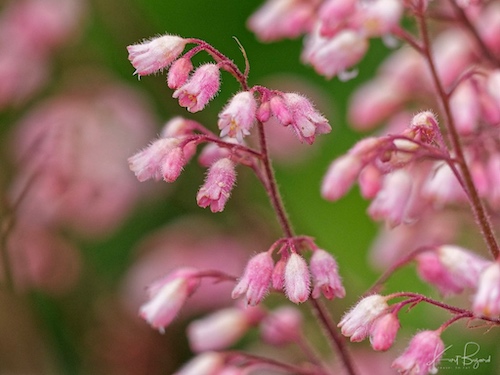

Pink Crevice Alumroot is a pink flowered form of the normally white flowered native alum root. Foliage forms handsome clumps topped with slender stalks 1 – 1 1/2 ft. tall of tiny pink flowers. Excellent in woodland setting for border, slope or rock garden. Drought tolerant but best with a little water. This species attracts hummingbirds. It is native to western North America from British Columbia to California, where it grows on rocky slopes and cliffs. This plant is quite variable in appearance. There are a number of wild and cultivated varieties.
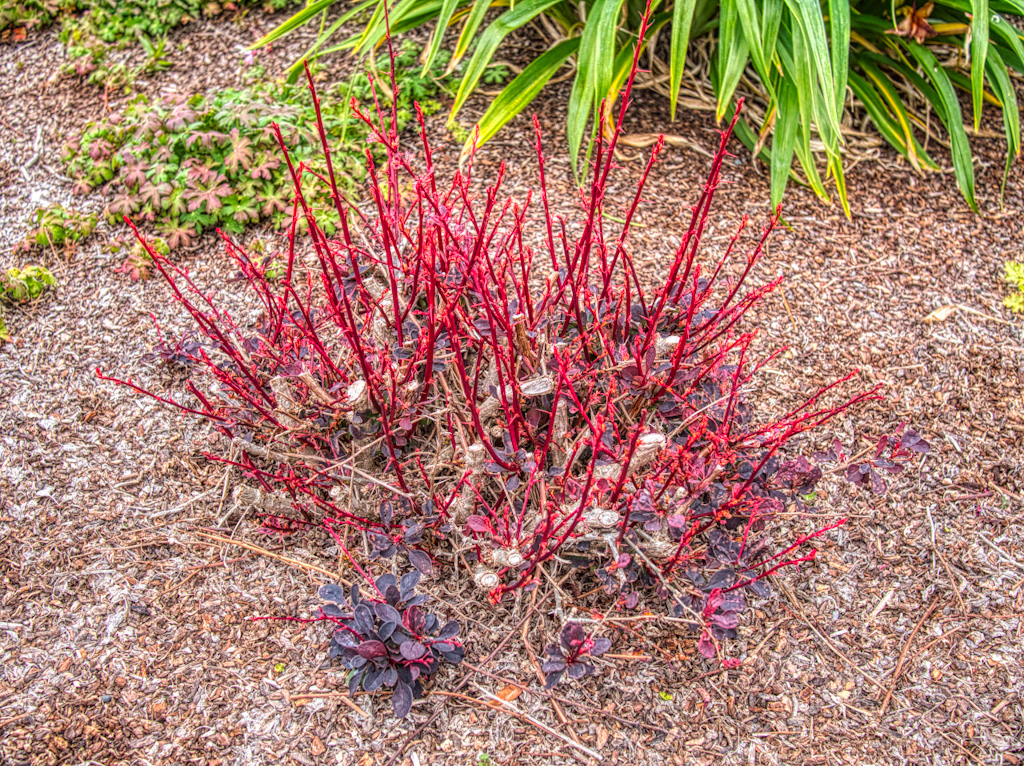
Berberis thunbergii, Japanese Barberry, Thunberg’s Barberry, or Red barberry, is a species of flowering plant in the barberry family, Berberidaceae, native to Japan and eastern Asia, though widely naturalized in China and in North America. This shrub is a show stopper for its stunning color. It has variegated leaves of purple, pink and rose shades. The more sun it gets, the more vibrant it appears. It grows well in partial sun in zones 4–8.

Pajaro Manzanita is native to coastal areas of southern Santa Cruz and northen Monterey counties. In the garden its combination of reddish new growth and pink flowers is striking. It can be pruned to ground cover height or allowed to mound up. Though native to the coast, it has performed well in inland gardens with well drained soil in sun to part shade. It has an unusually long bloom time for a manzanita. The horticultural variety ‘Paradise’ is most often available in nurseries.


Griffith’s Spurge Is native to Bhutan, Tibet and south west China. I included it because of the flowers close resemblance to Thorn of Crowns (Euphorbia milii) without the thorns. Of the many spurge now available to gardeners, this is one of the easiest and most reliable, particularly in colder climate areas although it is rated for zones 4–9.

Ceanothus ‘Skylark’ is a showy horticultural selection of the native “blueblossom” ceanothus. Its beautiful dark blue flowers are in bloom in the LCBNPG from spring through early summer. ‘Skylark’ ceanothus is drought tolerant but can also tolerate some water and does well in clay soils.


Ceanothus ‘Wheeler Canyon’ is a naturally occurring selection found in Wheeler Canyon in Ventura County. The original plant was discovered along the roadside in Wheeler Gorge in Ventura County, by Horticulturist Dara Emery of the Santa Barbara Botanic Garden. It is thought to be a Ceanothus papillosus var. roweanus hybrid. To me, these two Ceanothus look quite similar except for the shape of the leaves.
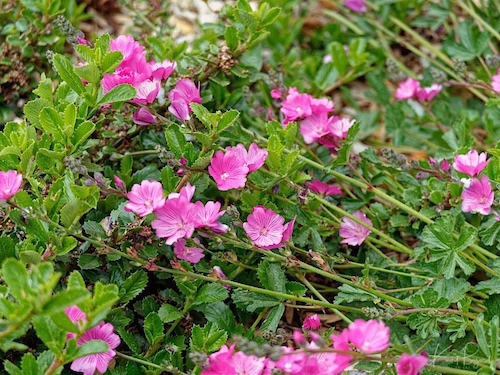
Sidalcea malviflora ssp. patula is a rare, endangered perennial herb that is native to northwest California, specifically Humboldt County. it often grows on the roadside and has been endangered by road widening. It occurs usually in wetlands, occasionally in non wetlands. This looks a lot like regular Checkerbloom (Sidalcea malviflora), a common western North American plant that is somewhat variable in appearance with many subspecies.

Hummingbird sage is native to southern and central California and is cultivated in gardens for its attractive flowering spikes and pleasant scent. It grows in the California coast ranges from the Sacramento Valley south to coastal Orange county in the the south. A common species that grows on shady slopes in oak woodland, chaparral, and coastal sage scrub. It is commonly found in oak woodlands not far from the Pacific Ocean.

Digitalis purpurea is a perennial herb that is not native to California; it was introduced from it’s native Europe and naturalized in the wild. It is considered an invasive species in California even though I still find it attractive.
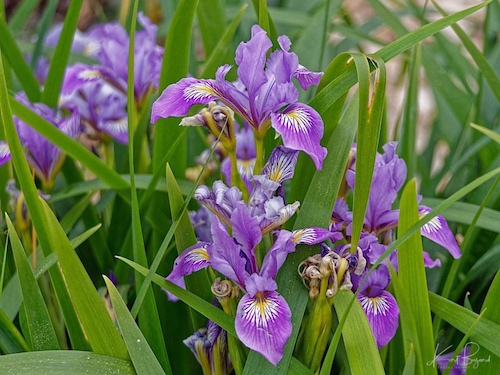
Douglas Iris is a common wildflower of the coastal regions of Northern and Central California and southern Oregon in the United States. The Douglas Iris was first described by 19th century botanist David Douglas in Monterey, California. It prefers part or full shade and richer soils and is fast growing near the coast. If not planted next to a creek or in a naturally wet area, it likes summer water every 2–4 weeks. It is more drought tolerant near the coast where it benefits from cooler temperatures and fog.
Ornamental Flowers

While I was wandering around taking pictures of birds, I saw a number of interesting flowering plants that I thought I would include in this post.
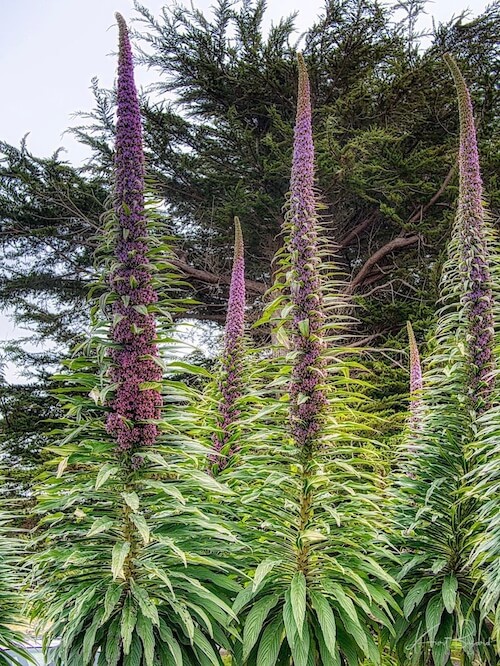
Tree Echium is endemic to the Canary Islands, where it is restricted to the island of La Palma. It is cultivated in gardens of Britain and Ireland, and it has naturalized along the northern California coast in San Mateo and Mendocino Counties. Its native habitat is laurel forests, where it is now endangered through habitat loss.

Portuguese squill, is a spring-blooming bulb with striking, lavender-blue flowers. The flowerheads can be the size of a softball, with star-like florets that open gradually over a period of 3 weeks or more. The plants have long, strappy leaves similar to a hyacinth, and grow 12–20” tall, with flowers on 6–12” stems. Although the epithet peruviana means “from Peru”, it is strictly a western Mediterranean species.
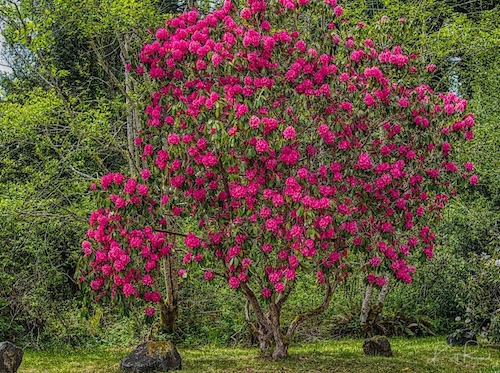

Rhododendron arboreum, the Tree Rhododendron, also known as Burans or Laligurans or simply Gurans in Nepal, is an evergreen shrub or small tree with a showy display of bright red flowers. It is found in Bhutan, China, India, Myanmar, Nepal, Sri Lanka, Pakistan and Thailand. Rhododendron arboreum is the national flower of Nepal.

I hope you enjoyed these beautiful flowers, if you visit Northern California, the Humboldt Botanical Garden is definitely worth a visit.

